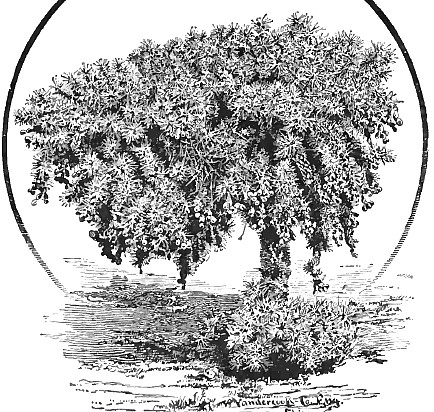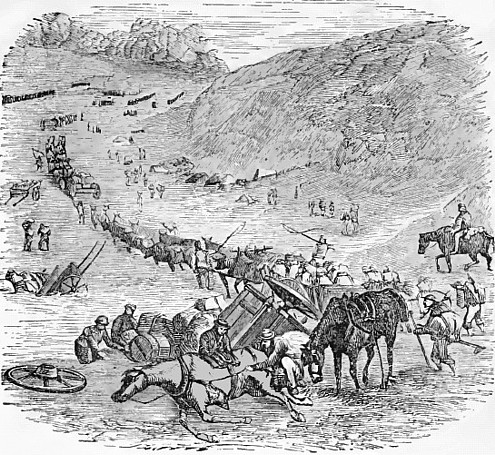The largest political division of the Territory, has long borne an enviable reputation for the richness and extent of its mines, and for years was the leading bullion producer of the Territory. The principal mineral belt of the county lies between the thirty fourth and thirty-fifth parallels of latitude, and extends from the Apache line to the boundary of Mohave. There is no part of the Territory so generally blessed with those two important factors in mining operations, wood and water. The formation of the mineral-bearing portion of Yavapai county is mostly a granite; porphyry, slate, and quartzite are encountered in many places, while the northern part shows sandstone, trap, and rock of volcanic origin. The mineral veins are noted for smooth, well-defined walls, high-grade ores, and great variety of mineral combinations. In its production of gold, Yavapai is the leading county of the Territory. The metal is found in nearly every portion of the mineral belt, in alluvial deposits, and in ledges. Silver occurs in native, wires and nuggets, chlorides, horn silver, silver glance, ruby silver, sulfides, black sulfides, and many other rich varieties. Copper ore is found in oxides, native, malachite, azurite blue carbonates, and as grey tetrahedrite copper.
The first mining by Americans in Yavapai county began in 1863, with the discovery of the rich placers at Weaver creek. About the same time the Walker party, from New Mexico, found the diggings of the Hassayampa and Lynx creek. Since then mining has been carried on with generally satisfactory results. Until the opening of the Southern Pacific railroad, two thirds of the bullion shipped from the Territory was produced in this county; and nearly half the mining locations in Arizona were made within its borders. Mining operations conducted by ignorant, incompetent, and sometimes dishonest men, have greatly retarded the development of Yavapai. Unfortunately, mining litigation has also done its share in this direction. But despite these obstacles, the intrinsic merit of the mines has been proven, and against bad management and costly litigation they have been made to pay. The opening of the railroad on the thirty-fifth parallel will give the mines of Yavapai all the advantages of cheap and rapid transportation; will bring its vast mineral wealth before the world, and make it, what its unrivaled climate and great natural advantages destined it to be, one of the leading mining camps on the coast.
Peck District.—This district is thirty miles south-east from Prescott, in the northern foothills of the Bradshaw range. It was organized in 1875, and has become famous for the wonderful richness of its ores. It has every advantage in the way of wood and water. Owing -to continuous litigation, the mines of the district have not been worked as mines of their richness and extent ought to be. No camp in the Territory has produced the same amount of bullion, considering the length of time it has been worked and the number of men employed. The Peck is one of the leading mines of the Territory. Discovered in 1875, it was worked successfully till 1878, when the owners became involved in a lawsuit which has not yet ended. The mine produced during that short period $1,200,000. Ore worth from $5,000 to $20,000 per ton was frequently met with. Pending the settlement of lawsuits, one of the finest properties in the Territory is lying idle. The rich vein is about 18 inches wide composed mainly of chlorides and carbonates. The average working test has been near $200 per ton. The mine is opened by a 400-foot shaft, and by four levels, aggregating 1,300 feet. A complete ten stamp mill and roaster have been erected on the property. The Peck is a strong vein, with prominent quartzite croppings traceable across the country for several miles.
The Silver Prince is situated about half a mile east of the Peck. It has produced very rich ore, similar in character to that of the Peck. Several tons of this ore shipped to San Francisco have averaged $1,000 per ton. The mine is opened by several shafts and drifts, and by a tunnel nearly 400 feet in length. The vein is a strong and well defined one, the richer ore bodies occurring in chambers or bunches. The Black Warrior lies south from the Prince and on the same vein. It is one of the finest properties in the camp; has been thoroughly opened by shafts, drifts, and tunnels. It shows a vein from 2 to 3 feet wide, composed of sulfides, galena, native and antimonial tetrahedrite silver, assaying on an average, $200 per ton. The Warrior and the Prince are the property of a New York company. The Asa Buffum is a northern extension of the Peck. It shows a small vein of exceedingly rich chloride and carbonate ore that assays $1,000 per ton. The Alta is situated south from the Peck, and between that ledge and the Silver Prince. It shows a vein from 1 to 2 feet wide of high-grade chloride ore, giving an assay of $300 per ton.
The Evening Star is the south extension of the Alta. It is opened by several shafts and drifts showing ore similar to the Alta, assaying from $300 to $1,000 per ton. The Lone Juniper is a south extension of the Black Warrior. It carries a vein from 1 to 2 feet of carbonates and chlorides assaying from $80 to $500 per ton. The property has been developed by several shafts, drifts, etc. The Doyle is south of the Warrior. It has a vein 2 feet wide of sulfide ore. Average assays go from $50 to $100 per ton. The mine has a 100- foot shaft and 100 tons of ore on the dump. The May Bean is the first south extension of the Peck, and has produced very rich ore. It is owned by the May Bean Mining Company, and is explored by several tunnels and shafts. The Curtin is the north extension of the Prince. It is a large vein, having but little work done upon it. The Silver Chief is situated between the Peck and the Silver Prince. It has a shaft 40 feet and shows rich ore. The St. Paul, some distance south of the Peck, is a large vein carrying ore that averages about $30 per ton. But little work has been done on it. The Austin, south of the St. Paul, has produced ore worth $5,000 per ton. There are a great many claims on the Peck ledge which show good surface indications. The most prominent of these is the General Kautz, opened by a tunnel over 100 feet in length. The New York is north of the Curtin. It is a large ledge, showing good ore and opened by several shafts.
Tiger District.—This district is situated about thirty-five miles south-east of Prescott, on the southern slope of the Bradshaw range. No camp in the Territory has better natural advantages for the mining and working of ores. Wood is found in every direction, and water is abundant; while the climate is all that could be desired. The formation is a granite. The district was organized in 1871, and contains many large and regular veins of native gold and silver ore. The cost of bringing in machinery, and the curse of litigation, have been the causes which have hindered the development of its valuable properties. The Tiger, which has given its name to the district, is one of the largest veins in the Territory, being over 70 feet between smooth and compact walls. It was the first silver mine of importance discovered in northern Arizona, and has produced some of the richest ore ever found in the Territory. The mine is opened by a three compartment working shaft, 300 feet deep, supplied with steam hoisting works, and equipped with cages and pumps. The ore is a sulfide, carrying native silver, and has worked on an average, $110 per ton. A ten-stamp mill with roaster attached has been erected. The mine has produced $200,000, $5,000 being gold. The claim is 1,200 feet long by 200 feet wide. The Hammond and Riggs claim is the second south extension of the Tiger. It is a large vein, showing fine ore, and has a tunnel driven along the ledge 150 feet, and a shaft 65 feet deep. The Linn ground is the first extension north. It shows a strong vein of high grade sulfide ore, and is opened by several shafts and cuts.
The Tiger is a true fissure and is located for three miles, the claims varying from 200 to 1,200 feet in length, most of which have been patented. Nearly all of the claims are opened by shafts and tunnels, showing large ore bodies similar in character to the discovery location. The Gray Eagle is about two miles east of the Tiger. It is a large vein of sulfide gold ore, carrying both gold and silver. Average assays give $46 in silver and $20 in gold. It is opened by 350 feet of tunnels. The Oro Bonito lies between the Tiger and the Gray Eagle; it shows a 3-foot vein of gold quartz, some of which has worked $80 per ton, in arrastras. The mine is opened by several shafts and tunnels. The Eclipse is about two miles east of the Tiger; it has from 1 to 3 feet of chloride and horn silver ore, assays from which have gone up into the thousands. A 60-foot shaft has been sunk on the mine. The Lorena is a small ledge east of the Eclipse; the ore is a chloride of silver and goes about $200 per ton. There is a shaft 80 feet deep and 100 tons of ore on the dump. The California and Benton are supposed to be northern extensions of the Tiger. They are strong veins and carry high-grade ore; the former has a shaft 100 feet, and the latter 50 feet deep. The Moreland is the north extension of the Benton; it is a large vein, carrying some very rich silver ore.
The Buckeye is situated in what is known as Bradshaw Basin. It is a small ledge of very rich ore—gold and silver. It has produced several thousand dollars, and is opened by shafts and tunnels. The Kansas is east of the Buckeye; it has a strong vein of sulfide ore, and has been explored by a tunnel, over 100 feet in length. The Thurman is a 3-foot vein of sulfides carrying gold and silver, and assaying $60 per ton. Several shafts have been sunk on the property. There are many other valuable claims in the "Basin " on which but little work Las been done. A ten-stamp custom mill has been erected at this place.
North of the Tiger district, in what was formerly known as Pine Grove, are several fine properties, foremost among which is the War Eagle, a vein from 2 to 5 feet wide, carrying native gold and silver, which has worked from $25 to $40 per ton. The discovery claim is opened by a shaft 90 feet deep. It has produced over $30,000, and is one of the most valuable properties in the Bradshaws. The claim has been located for several miles, the extensions all showing finely. The Del Pasco, Bradshaw, Blandena, Cougar, Gretna, Shelton, and many other promising claims, are in the Tiger and Pine Grove districts. About five miles west of the Tiger is located the Southern Belle, a ledge of gold quartz from 4 to 5 feet wide; the ore, worked in arrastras, has yielded from $30 to $50 per ton. Several shafts and open cuts show a well-defined lode.
Return
to The Arizona Page:
Arizona Gold Rush Mining History



